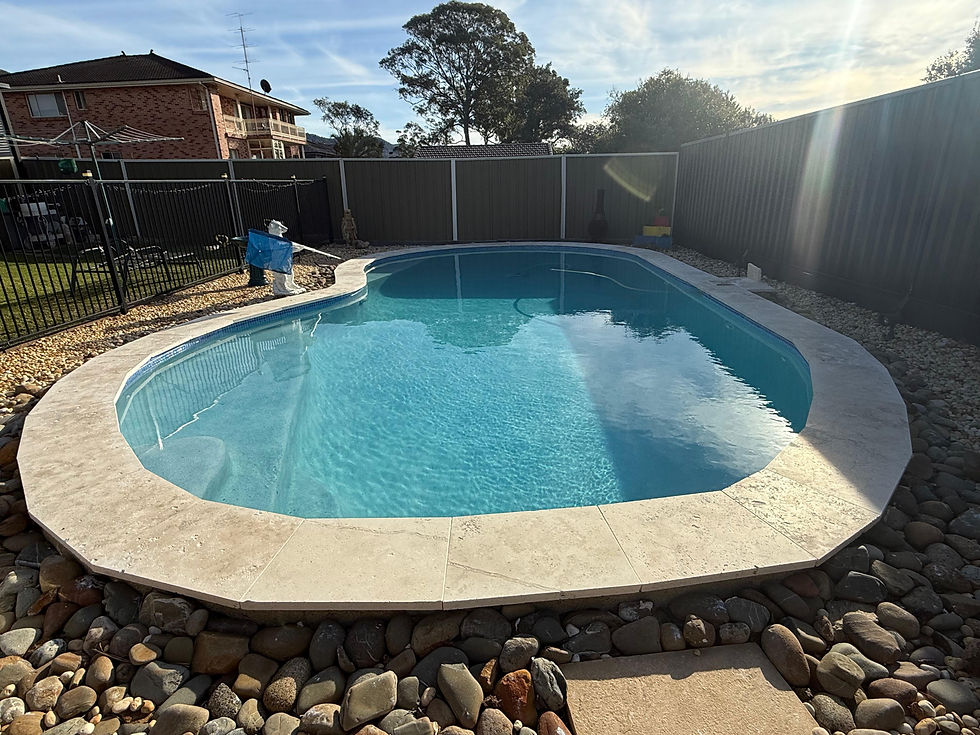Care Instructions for Your Fibreglass Pool
- SPLASH POOL & SPA
- Jul 2
- 3 min read
Updated: Dec 4

We’d like to provide you with some essential information on maintaining your newly renovated fibreglass pool. Fibreglass pools require far less maintenance than concrete or vinyl pools thanks to their smooth, gel-coated surface, which is less porous and more resistant to chemical damage. With proper care, your pool will remain in excellent condition for decades.
1. Wait Until Water Reaches Skimmer Level
Once your pool is filled, wait until the water reaches the skimmer box before switching on your filtration system as normal.
2. No Chemicals for the First 7 Days (Important for All Pools)
Regardless of whether your pool uses chlorine or saltwater, do not add any chemicals during the first 7 days. This curing period is crucial to allow the new surface to stabilise. You may use the pool during this time, but avoid introducing any chemical treatments.
3. Saltwater Pools – Delay Salt Addition
If your pool is a saltwater system, do not add salt or activate the salt chlorinator for at least 7 days after filling. Adding salt too early can damage the new surface.
4. Start Chemical Treatment After 7 Days
After the 7-day curing period, we recommend taking a fresh water sample to your local pool shop. Let them know your pool has a new fibreglass surface so they can help you reset the chemical balance from scratch. Follow their guidance carefully, based on your pool’s volume and system type.
💧 Water Chemistry Guidelines (Fibreglass Pools)
Maintaining correct water chemistry is vital to protect your pool’s surface and equipment.
Chlorine: 1.0 – 2.0 ppm (never exceed 4.0 ppm). Higher levels will damage the gelcoat surface.
pH: 7.2 – 7.8 (ideal for fibreglass: 7.2 – 7.4, balancing gelcoat longevity with swimmer comfort).
Total Alkalinity: 80 – 120 ppm (can be up to 300 ppm, but ideally 80 – 100 ppm for stability).
Calcium Hardness: 90 – 300 ppm (soft water is corrosive; hard water causes scaling).
Cyanuric Acid (Stabiliser): 30 – 50 ppm recommended (per local pool shop guidance).
Total Dissolved Solids (TDS): < 1,500 ppm. Check annually with a pool professional.
📌 Why this matters:
Low pH = corrosive water that can damage gelcoat and equipment.
High pH = chlorine becomes less effective (at 7.8 pH, chlorine effectiveness drops by half).
Poor balance can cause chalking, staining, or surface blistering.
Tip: Use the Langelier Saturation Index (LSI) to confirm water balance. Keep LSI between -0.5 and +0.5 (slightly positive is safer than negative).
🧽 Maintenance Best Practices
Brush and clean the pool weekly (twice weekly for the first month).
Test water chemistry weekly with a reliable kit.
Run the filtration system daily (minimum 8 hours).
Use a robotic or automatic cleaner where possible.
Keep water level above the skimmer.
Avoid superchlorination/shocking the pool — this can bleach or damage the gelcoat.
Schedule professional servicing at least once per year.
🌟 Important Notes
Always add chemicals gradually and pre-dilute when possible.
Collect water samples from about 45 cm (18 inches) below the surface, ideally near a return jet.
Do not leave the pool drained or partially drained for long periods.
Maintain a logbook of chemical treatments (date, product, dosage).
Non-compliance with water chemistry may void your warranty.
It’s vital for saltwater system swimming pools to use high-quality products that dissolve completely upon contact with water. If a product does not dissolve immediately, it’s important to use a pool brush or broom to distribute it, so that the undissolved material does not sit in one place on the pool surface. This helps to prevent stains or discolouration.
Using low-quality products, or failing to ensure proper dissolution, can lead to permanent stains on pool surfaces — damage that is usually not covered by warranty. Even products labelled for pool use can contain impurities or coarse particles that settle and react, especially if the salt used is of poor purity. In saltwater pools, metals or minerals introduced by impure salt can combine with chlorine or with pool surfaces to produce visible stains.
To avoid problems:
Always choose chemical and salt products specifically graded for pool / saltwater systems.
Pre-dissolve or distribute carefully, especially in areas where water circulation is weaker (steps, shallow ends).
Run circulation and filtration soon after adding chemicals to ensure even mixing.
Brush or sweep the pool surface if you notice undissolved product settling.
Maintain correct water chemistry (pH, chlorine levels, total alkalinity), which helps prevent discolouration and metal precipitation.
Dissolve first in a bucket if needed
Add slowly while pump/circulation is running
Brush / sweep undissolved granules
Test water after treatment
If you have any questions or need assistance, please contact us. We’re here to support you and ensure your fibreglass pool stays crystal clear, smooth, and long-lasting.






Comments